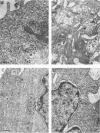Abstract
Three adenovirus type 2-specified immunogens elicited neutralizing antibodies when injected into rabbits; these were the fiber, the hexon, and the penton base. Adenovirus type 2 virions, neutralized by antihexon- or anti-penton base antisera, attached to HeLa cells to the same extent as untreated control virus, and after attachment, neutralized viruses also became sensitive to DNase treatment. A fraction of 75 to 80% of the attached antibody-treated virions penetrated the plasma membrane, which should be compared with an 84 to 88% penetration level in the control series. A majority of the antihexon-neutralized virions was found in intracellular vesicles, as revealed with an electron microscope, but in the case of anti-penton base neutralization, a maximum of 50% of the virions was retained within vesicles, and ca. 30% was free in the cytoplasmic compartment. A value greater than 45% was never obtained for neutralization with a monospecific anti-penton base antiserum, which could imply the existence of alternative pathways for virus penetration into HeLa cells--one of these being sensitive to treatment with anti-penton base antiserum. Antisera containing antifiber specificities efficiently aggregated virions, and the aggregation data mirrored the degree of neutralization. Antifiber-neutralized virions attached to cells to a three- to five times greater extent than untreated control virus, but the former virions had a reduced ability to become sensitive to DNase treatment. Around 15% of the attached antifiber-treated virions was found as large aggregates inside multivesicular bodies or lysosomes.
Full text
PDF
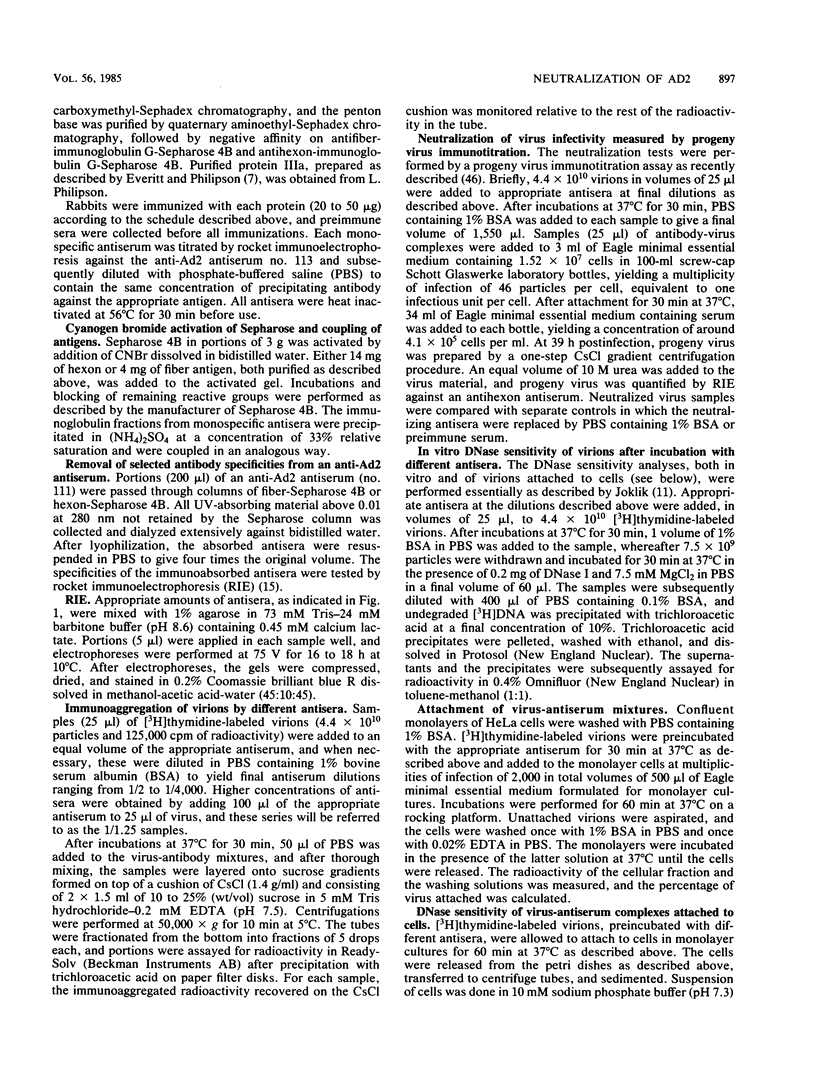
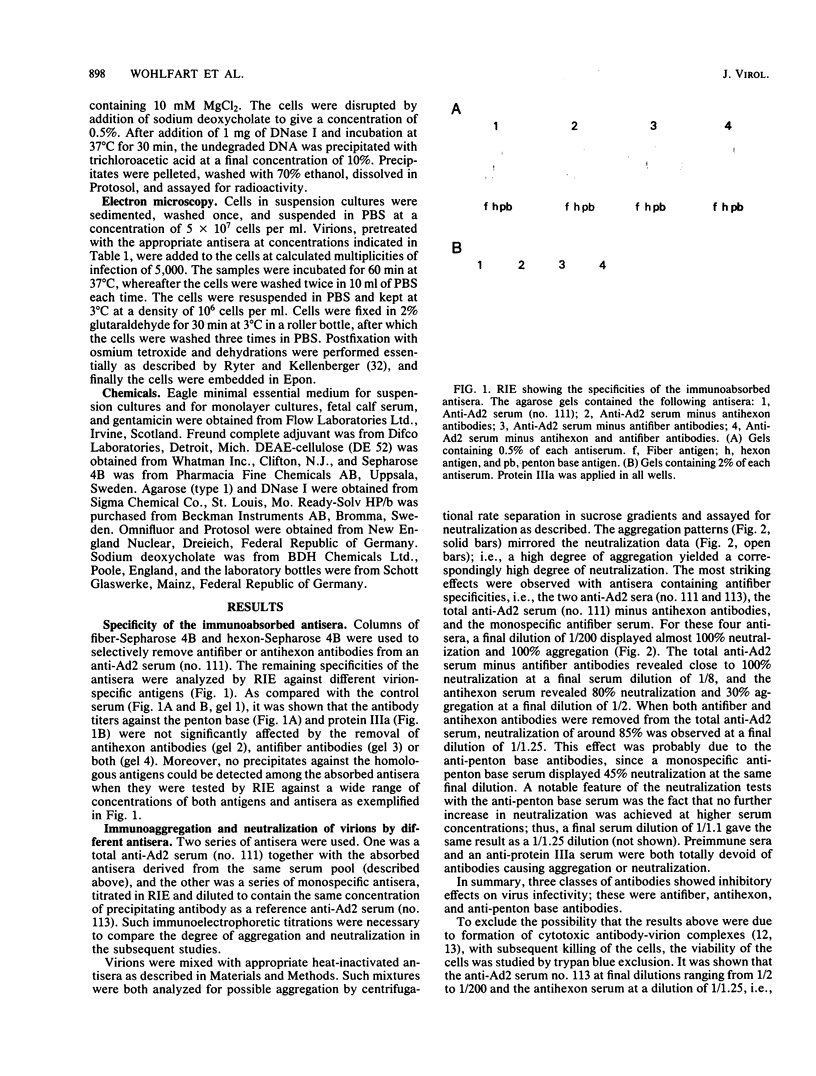
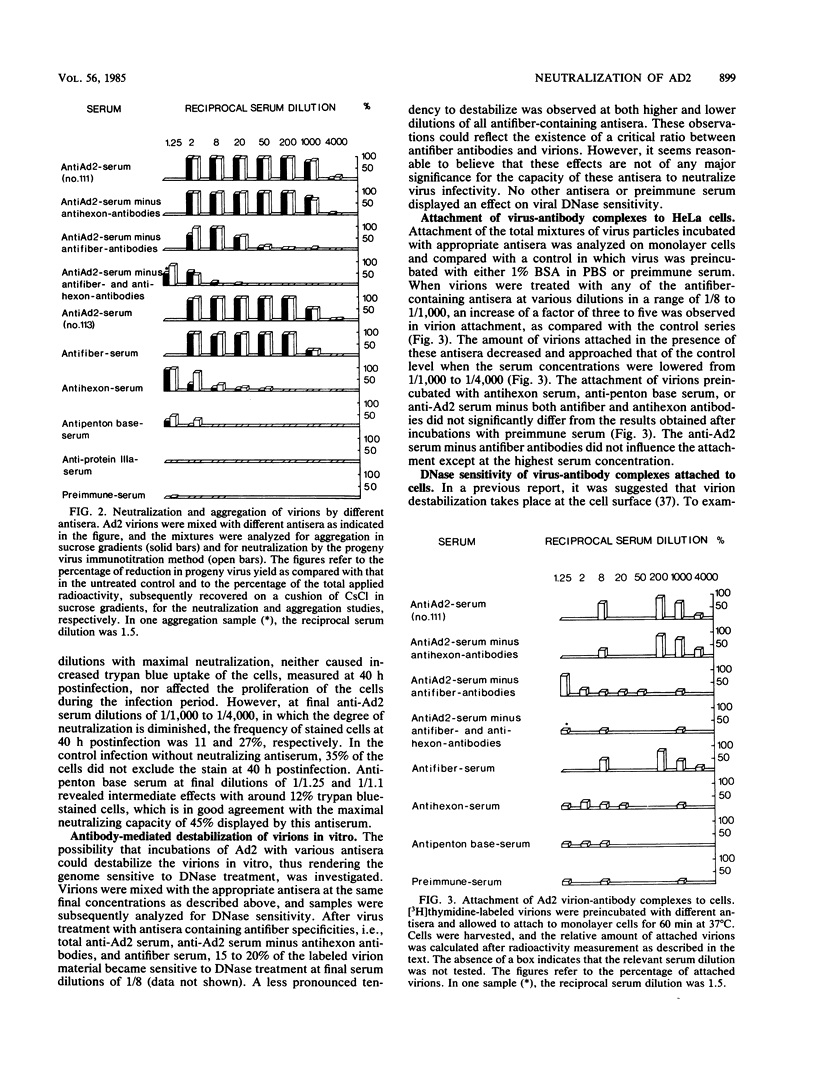
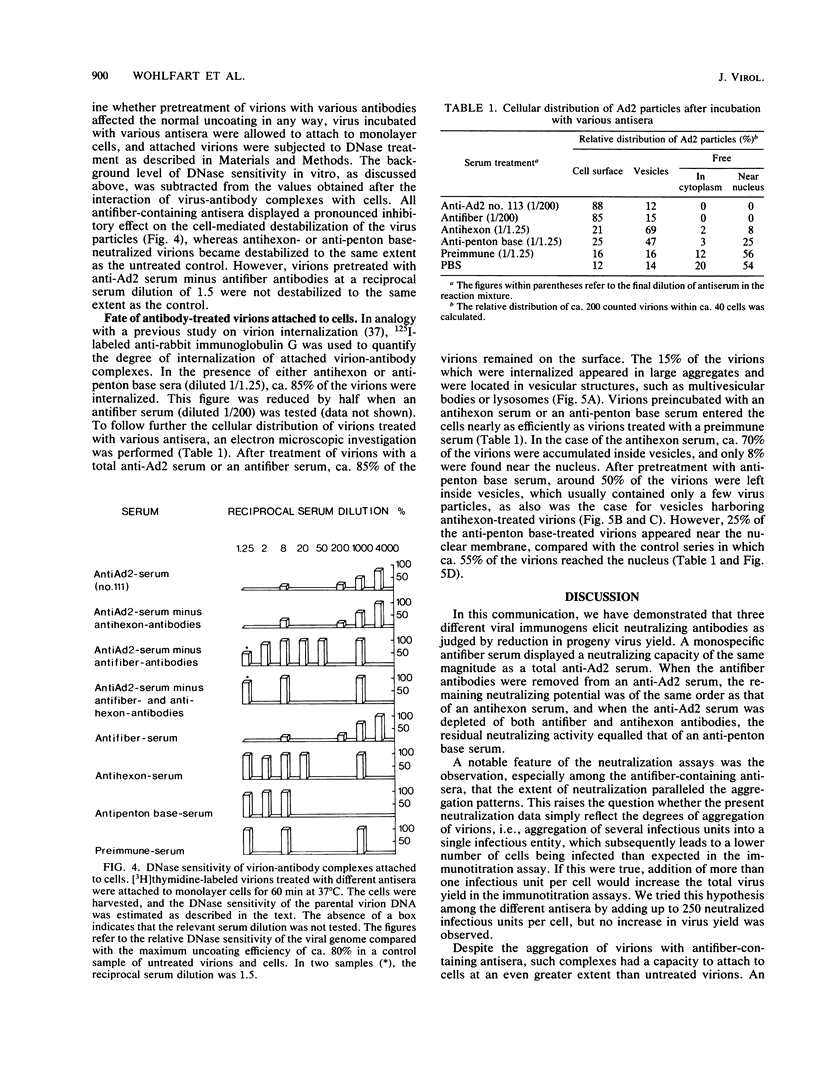
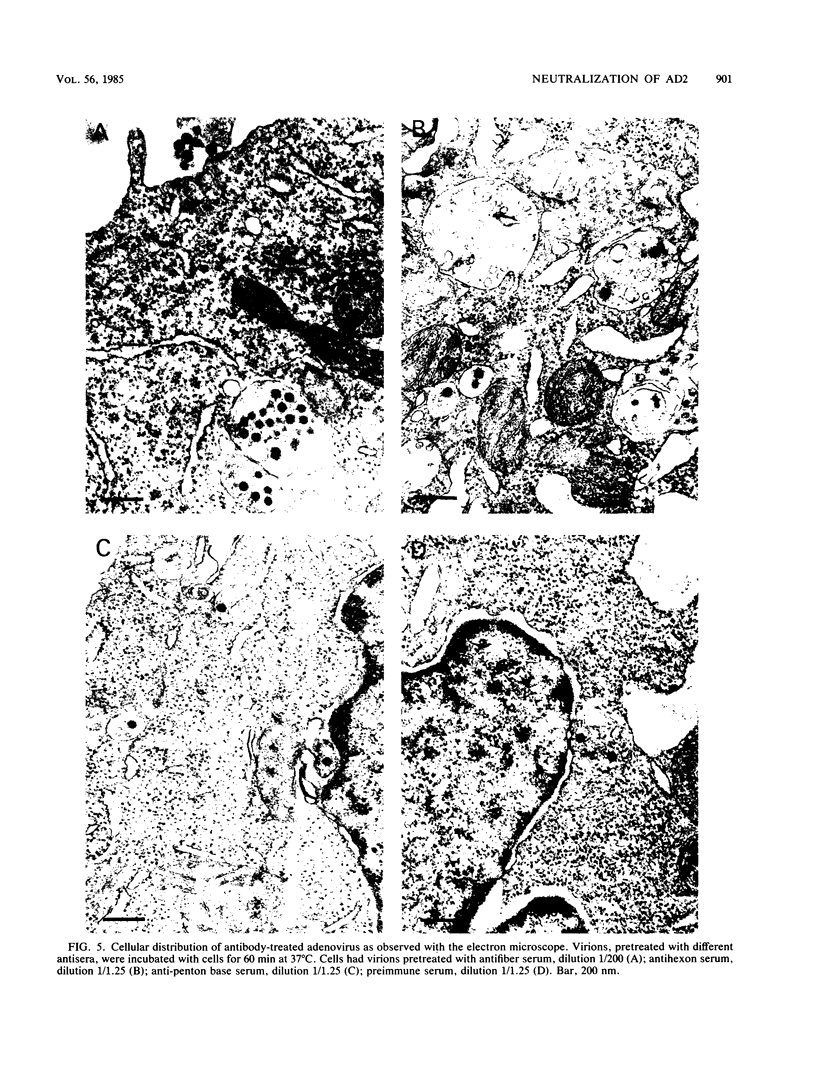
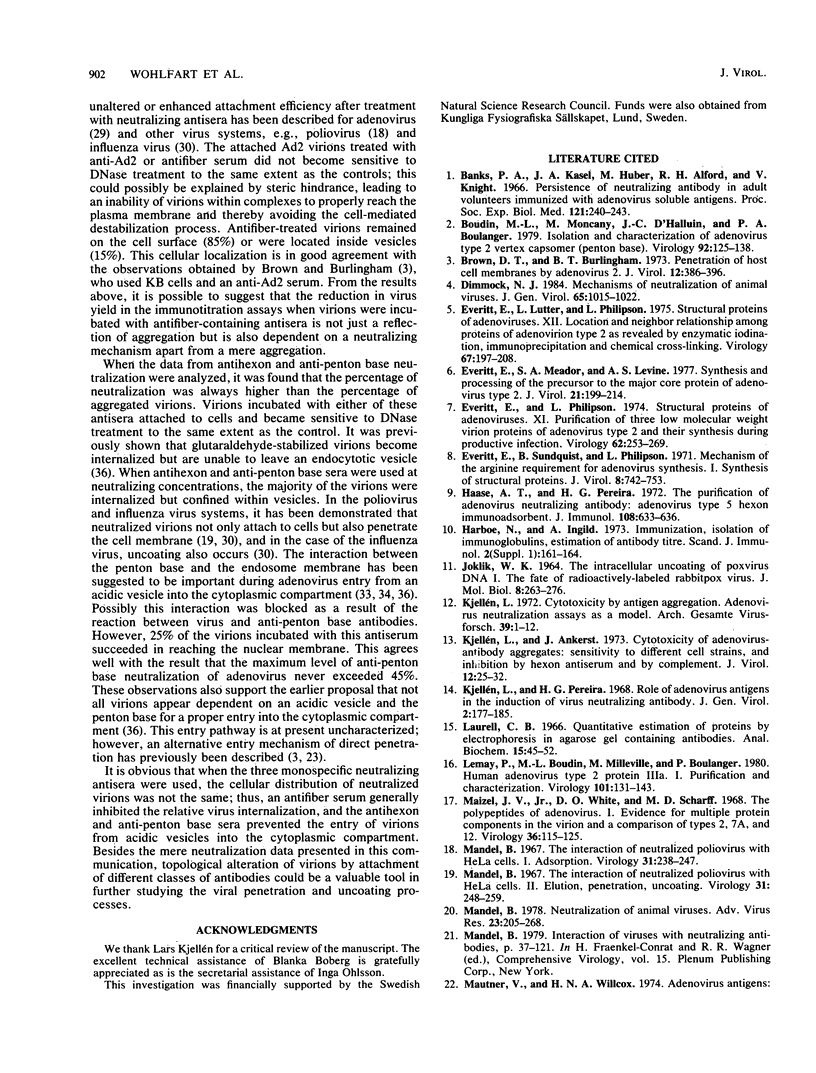
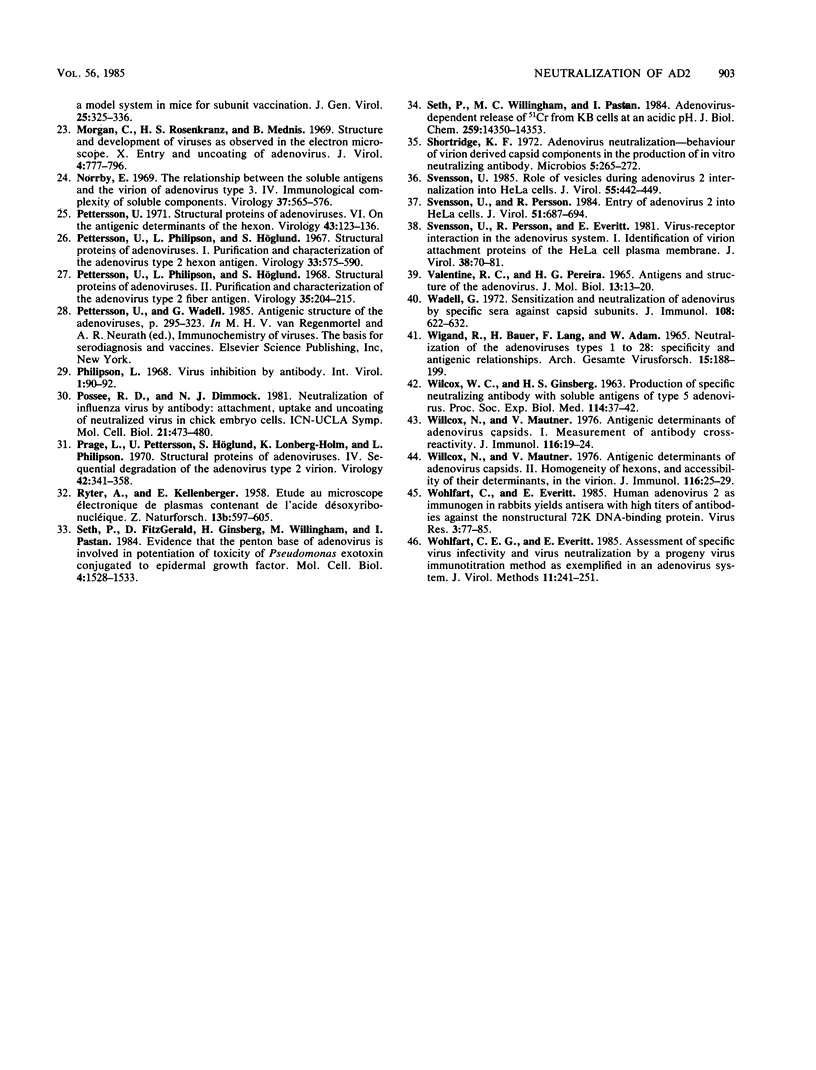
Images in this article
Selected References
These references are in PubMed. This may not be the complete list of references from this article.
- Banks P. A., Kasel J. A., Huber M., Alford R. H., Knight V. Persistence of neutralizing antibody in adult volunteers immunized with adnovirus soluble antigens. Proc Soc Exp Biol Med. 1966 Jan;121(1):240–243. doi: 10.3181/00379727-121-30747. [DOI] [PubMed] [Google Scholar]
- Boudin M. L., Moncany M., D'Halluin J. C., Boulanger P. A. Isolation and characterization of adenovirus type 2 vertex capsomer (penton base). Virology. 1979 Jan 15;92(1):125–138. doi: 10.1016/0042-6822(79)90219-8. [DOI] [PubMed] [Google Scholar]
- Brown D. T., Burlingham B. T. Penetration of host cell membranes by adenovirus 2. J Virol. 1973 Aug;12(2):386–396. doi: 10.1128/jvi.12.2.386-396.1973. [DOI] [PMC free article] [PubMed] [Google Scholar]
- Dimmock N. J. Mechanisms of neutralization of animal viruses. J Gen Virol. 1984 Jun;65(Pt 6):1015–1022. doi: 10.1099/0022-1317-65-6-1015. [DOI] [PubMed] [Google Scholar]
- Everitt E., Lutter L., Philipson L. Structural proteins of adenoviruses. XII. Location and neighbor relationship among proteins of adenovirion type 2 as revealed by enzymatic iodination, immunoprecipitation and chemical cross-linking. Virology. 1975 Sep;67(1):197–208. doi: 10.1016/0042-6822(75)90417-1. [DOI] [PubMed] [Google Scholar]
- Everitt E., Meador S. A., Levine A. S. Synthesis and processing of the precursor to the major core protein of adenovirus type 2. J Virol. 1977 Jan;21(1):199–214. doi: 10.1128/jvi.21.1.199-214.1977. [DOI] [PMC free article] [PubMed] [Google Scholar]
- Everitt E., Philipson L. Structural proteins of adenoviruses. XI. Purification of three low molecular weight virion proteins of adenovirus type 2 and their synthesis during productive infection. Virology. 1974 Nov;62(1):253–269. doi: 10.1016/0042-6822(74)90320-1. [DOI] [PubMed] [Google Scholar]
- Everitt E., Sundquist B., Philipson L. Mechanism of the arginine requirement for adenovirus synthesis. I. Synthesis of structural proteins. J Virol. 1971 Nov;8(5):742–753. doi: 10.1128/jvi.8.5.742-753.1971. [DOI] [PMC free article] [PubMed] [Google Scholar]
- Haase A. T., Pereira H. G. The purification of adenovirus neutralizing antibody: adenovirus type 5 hexon immunoadsorbent. J Immunol. 1972 Mar;108(3):633–636. [PubMed] [Google Scholar]
- Harboe N., Ingild A. Immunization, isolation of immunoglobulins, estimation of antibody titre. Scand J Immunol Suppl. 1973;1:161–164. doi: 10.1111/j.1365-3083.1973.tb03798.x. [DOI] [PubMed] [Google Scholar]
- JOKLIK W. K. THE INTRACELLULAR UNCOATING OF POXVIRUS DNA. I. THE FATE OF RADIOACTIVELY-LABELED RABBITPOX VIRUS. J Mol Biol. 1964 Feb;8:263–276. doi: 10.1016/s0022-2836(64)80136-4. [DOI] [PubMed] [Google Scholar]
- Kjellén L., Ankerst J. Cytotoxicity of adenovirus-antibody aggregates: sensitivity to different cell strains, and inhibition by hexon antiserum and by complement. J Virol. 1973 Jul;12(1):25–32. doi: 10.1128/jvi.12.1.25-32.1973. [DOI] [PMC free article] [PubMed] [Google Scholar]
- Kjellén L. Cytotoxicity by antigen aggregation. Adenovirus neutralization assays as a model. Arch Gesamte Virusforsch. 1972;39(1):1–12. doi: 10.1007/BF01241524. [DOI] [PubMed] [Google Scholar]
- Kjellén L., Pereira H. G. Role of adenovirus antigens in the induction of virus neutralizing antibody. J Gen Virol. 1968 Jan;2(1):177–185. doi: 10.1099/0022-1317-2-1-177. [DOI] [PubMed] [Google Scholar]
- Laurell C. B. Quantitative estimation of proteins by electrophoresis in agarose gel containing antibodies. Anal Biochem. 1966 Apr;15(1):45–52. doi: 10.1016/0003-2697(66)90246-6. [DOI] [PubMed] [Google Scholar]
- Lemay P., Boudin M. L., Milleville M., Boulanger P. Human adenovirus type 2 protein IIIa. I. Purification and characterization. Virology. 1980 Feb;101(1):131–143. doi: 10.1016/0042-6822(80)90490-0. [DOI] [PubMed] [Google Scholar]
- Maizel J. V., Jr, White D. O., Scharff M. D. The polypeptides of adenovirus. I. Evidence for multiple protein components in the virion and a comparison of types 2, 7A, and 12. Virology. 1968 Sep;36(1):115–125. doi: 10.1016/0042-6822(68)90121-9. [DOI] [PubMed] [Google Scholar]
- Mandel B. Neutralization of animal viruses. Adv Virus Res. 1978;23:205–268. doi: 10.1016/S0065-3527(08)60101-3. [DOI] [PMC free article] [PubMed] [Google Scholar]
- Mandel B. The interaction of neutralized poliovirus with HeLa cells. I. Adsorption. Virology. 1967 Feb;31(2):238–247. doi: 10.1016/0042-6822(67)90167-5. [DOI] [PubMed] [Google Scholar]
- Mautner V., Willcox H. N. Adenovirus antigens: a model system in mice for subunit vaccination. J Gen Virol. 1974 Dec;25(3):325–336. doi: 10.1099/0022-1317-25-3-325. [DOI] [PubMed] [Google Scholar]
- Morgan C., Rosenkranz H. S., Mednis B. Structure and development of viruses as observed in the electron microscope. V. Entry and uncoating of adenovirus. J Virol. 1969 Nov;4(5):777–796. doi: 10.1128/jvi.4.5.777-796.1969. [DOI] [PMC free article] [PubMed] [Google Scholar]
- Norrby E. The relationship between the soluble antigens and the virion of adenovirus type 3. IV. Immunological complexity of soluble components. Virology. 1969 Apr;37(4):565–576. doi: 10.1016/0042-6822(69)90274-8. [DOI] [PubMed] [Google Scholar]
- Pettersson U., Philipson L., Höglund S. Structural proteins of adenoviruses. I. Purification and characterization of the adenovirus type 2 hexon antigen. Virology. 1967 Dec;33(4):575–590. doi: 10.1016/0042-6822(67)90057-8. [DOI] [PubMed] [Google Scholar]
- Pettersson U., Philipson L., Höglund S. Structural proteins of adenoviruses. II. Purification and characterization of the adenovirus type 2 fiber antigen. Virology. 1968 Jun;35(2):204–215. doi: 10.1016/0042-6822(68)90261-4. [DOI] [PubMed] [Google Scholar]
- Pettersson U. Structural proteins of adenoviruses. VI. On the antigenic determinants of the hexon. Virology. 1971 Jan;43(1):123–136. doi: 10.1016/0042-6822(71)90230-3. [DOI] [PubMed] [Google Scholar]
- Prage L., Pettersson U., Höglund S., Lonberg-Holm K., Philipson L. Structural proteins of adenoviruses. IV. Sequential degradation of the adenovirus type 2 virion. Virology. 1970 Oct;42(2):341–358. doi: 10.1016/0042-6822(70)90278-3. [DOI] [PubMed] [Google Scholar]
- RYTER A., KELLENBERGER E., BIRCHANDERSEN A., MAALOE O. Etude au microscope électronique de plasmas contenant de l'acide désoxyribonucliéique. I. Les nucléoides des bactéries en croissance active. Z Naturforsch B. 1958 Sep;13B(9):597–605. [PubMed] [Google Scholar]
- Seth P., Fitzgerald D., Ginsberg H., Willingham M., Pastan I. Evidence that the penton base of adenovirus is involved in potentiation of toxicity of Pseudomonas exotoxin conjugated to epidermal growth factor. Mol Cell Biol. 1984 Aug;4(8):1528–1533. doi: 10.1128/mcb.4.8.1528. [DOI] [PMC free article] [PubMed] [Google Scholar]
- Seth P., Willingham M. C., Pastan I. Adenovirus-dependent release of 51Cr from KB cells at an acidic pH. J Biol Chem. 1984 Dec 10;259(23):14350–14353. [PubMed] [Google Scholar]
- Shortridge K. F. Adenovirus neutralization--behavior of virion derived capsid components in the production of in vitro neutralizing antibody. Microbios. 1972;5(20):265–272. [PubMed] [Google Scholar]
- Svensson U., Persson R. Entry of adenovirus 2 into HeLa cells. J Virol. 1984 Sep;51(3):687–694. doi: 10.1128/jvi.51.3.687-694.1984. [DOI] [PMC free article] [PubMed] [Google Scholar]
- Svensson U., Persson R., Everitt E. Virus-receptor interaction in the adenovirus system I. Identification of virion attachment proteins of the HeLa cell plasma membrane. J Virol. 1981 Apr;38(1):70–81. doi: 10.1128/jvi.38.1.70-81.1981. [DOI] [PMC free article] [PubMed] [Google Scholar]
- Svensson U. Role of vesicles during adenovirus 2 internalization into HeLa cells. J Virol. 1985 Aug;55(2):442–449. doi: 10.1128/jvi.55.2.442-449.1985. [DOI] [PMC free article] [PubMed] [Google Scholar]
- Valentine R. C., Pereira H. G. Antigens and structure of the adenovirus. J Mol Biol. 1965 Aug;13(1):13–20. doi: 10.1016/s0022-2836(65)80076-6. [DOI] [PubMed] [Google Scholar]
- WIGAND R., BAUER H., LANG F., ADAM W. NEUTRALIZATION OF THE ADENOVIRUSES TYPES 1 TO 28: SPECIFICITY AND ANTIGENIC RELATIONSHIPS. Arch Gesamte Virusforsch. 1965;15:188–199. doi: 10.1007/BF01257730. [DOI] [PubMed] [Google Scholar]
- WILCOX W. C., GINSBERG H. S. PRODUCTION OF SPECIFIC NEUTRALIZING ANTIBODY WITH SOLUBLE ANTIGENS OF TYPE 5 ADENOVIRUS. Proc Soc Exp Biol Med. 1963 Oct;114:37–42. doi: 10.3181/00379727-114-28579. [DOI] [PubMed] [Google Scholar]
- Wadell G. Sensitization and neutralization of adenovirus by specific sera against capsid subunits. J Immunol. 1972 Mar;108(3):622–632. [PubMed] [Google Scholar]
- Willcox N., Mautner V. Antigenic determinants of adenovirus capsids. I. Measurement of antibody cross-reactivity. J Immunol. 1976 Jan;116(1):19–24. [PubMed] [Google Scholar]
- Willcox N., Mautner V. Antigenic determinants of adenovirus capsids. II. Homogeneity of hexons, and accessibility of their determinants, in the virion. J Immunol. 1976 Jan;116(1):25–29. [PubMed] [Google Scholar]
- Wohlfart C. E., Everitt E. Assessment of specific virus infectivity and virus neutralization by a progeny virus immunotitration method as exemplified in an adenovirus system. J Virol Methods. 1985 Jul;11(3):241–251. doi: 10.1016/0166-0934(85)90113-2. [DOI] [PubMed] [Google Scholar]
- Wohlfart C., Everitt E. Human adenovirus 2 as immunogen in rabbits yields antisera with high titers of antibodies against the nonstructural 72K DNA-binding protein. Virus Res. 1985 Jul;3(1):77–85. doi: 10.1016/0168-1702(85)90043-7. [DOI] [PubMed] [Google Scholar]




